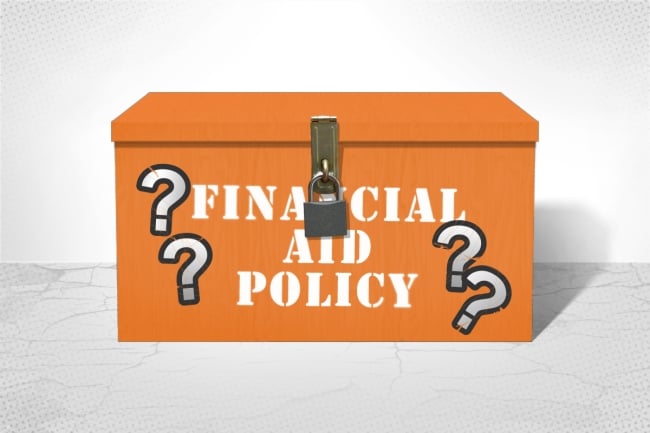You have /5 articles left.
Sign up for a free account or log in.

Student aid policy under a new Trump administration could include cutting work-study and expanding federal aid to credential programs.
Photo illustration by Justin Morrison/Inside Higher Ed | selimaksan/iStock/Getty Images
For all the political oxygen that higher education consumed during Donald Trump’s four years out of office, the once and future president has yet to put forth a comprehensive policy agenda on postsecondary education for his second term—including how he’ll approach federal financial aid and programs to ease postsecondary access.
He has called for the abolition of the Education Department, a move that would relegate most financial aid responsibilities to the states and strand a massive federal operation with no home. Some have suggested that the Office of Federal Student Aid and its 1,500-plus employees, responsible for enacting federal aid and student loan policy, could be rehoused in the Treasury Department.
A half dozen experts who spoke with Inside Higher Ed agreed that dismantling the Education Department is an implausible outcome. What’s more likely, they said, is that Trump and a Republican-dominated Congress will advance significant cuts to the Education Department’s funding, and to financial aid programs in particular.
The last Trump administration proposed slashing the Education Department’s budget every year he was in power, including large cuts to financial aid—its 2020 budget called for a $5.6 billion reduction in funding, a nearly 8 percent cut. The administration targeted Federal Work-Study in particular, calling for “significant” reductions to the program in 2017 and again in 2018. In 2020 Trump’s budget proposal included a $630 million cut to the program—about half of its total budget—and called for the complete elimination of federal Supplemental Educational Opportunity Grant programs, which fill gaps in aid for students with extraordinary financial need.
With a fully Republican-controlled Congress, those cuts could finally come to fruition. Current Pell funding is probably safe; there’s too much political downside for lawmakers to take direct benefits away from their constituents. But other federal college-access initiatives—from work-study to academic supports like Upward Bound to debt-relief programs like Public Service Loan Forgiveness—could be on the cutting block.
Jon Fansmith, senior vice president for government relations at the American Council on Education, said that without those federally funded aid and access initiatives, federal grants alone won’t be as effective.
“You look at those college-access programs and the populations they serve, and you do have to worry about the types of support that will be available to students,” he said. “There’s very little on the table that I’m not worried about.”
Kim Cook, CEO of the National College Attainment Network, said her organization would continue to advocate for raising the maximum Pell Grant and putting more money into federal financial aid programs. She acknowledged that the case “may be harder to make” under Trump, but said support for financial aid expansion can sometimes be surprisingly bipartisan. The most recent expansion of Pell eligibility, enshrined in the FAFSA Simplification Act, was championed by former Republican senator Lamar Alexander and signed into law by Trump himself.
“It’s not always a binary thing,” she said. “We haven’t given up the fight.”
Disruption and ‘Accountability’
The presidential transition could disrupt this cycle’s FAFSA rollout, just as all eyes are on the form after a disastrous launch last year. As the Education Department turns over and leaders who’ve dealt with the form for the past four years hand off responsibility, some fear the friction could lead to further delays in the spring.
But there’s also bipartisan agreement on the department’s failings last cycle, and the new administration will face immense pressure to ensure this one goes smoothly.
Education Secretary Miguel Cardona “won’t be too happy about working with the Trump transition team, and that could create some problems with the FAFSA,” said Preston Cooper, a senior fellow at the conservative think tank the American Enterprise Institute. “But if they can come in and clean up the mess, that would be a big PR win.”
Trump likely won’t just be looking to undo his predecessor’s successes or fix his mistakes; a number of new policy changes are on the agenda in a Trump-led trifecta government.
Cooper said he expects Trump and Republicans in Congress to reframe Title IV eligibility requirements, which determine what degree programs can receive federal financial aid, around postgraduate outcomes like employment prospects and student debt.
“There’s going to be a real movement towards accountability,” he said. “We may start to look more skeptically at some programs and ask, ‘Why are these receiving taxpayer money?’ And we may look at others and say, ‘Why aren’t these?’”
That could mean a heyday for institutions offering short-term credentials and career training. Under President Biden, House Republicans introduced legislation that would have expanded Pell Grant eligibility to workforce training and short-term credential programs—paying for the expansion by charging the wealthiest colleges for unpaid student loans—but were stymied by opposition from congressional Democrats. Short-term Pell, as the bill is known, could have a much better chance of passing through the new Congress.
Cook said she worried that short-term Pell could have downstream consequences for federal student aid as a whole. If Pell money is rerouted to apprenticeships and credential programs without increasing overall funding for the grant, that could cause a budget shortfall—which in turn could put current students’ Pell Grants at risk.
“Once you reach that point, it forces really devastating conversations about eligibility and award amounts,” she said. “So we’re thinking about, what guardrails do we need to put up to protect students’ aid if this does happen?”
Cooper conceded that a shift in the types of degree programs qualifying for federal aid would have ramifications for students currently receiving Pell Grants. But he added that in the long run it could also prevent students from taking on debt for less valuable degrees.
“If those programs lose access to federal aid, it’s possible some students won’t be able to attend them anymore,” he said. “But if the program had terrible employment outcomes, you might see that as a bullet dodged rather than opportunity denied.”
Outside of administration policies or congressional action, some say another Trump presidency indicates a cultural shift that could have broad implications for institutional aid and state grant programs.
Scholarships and financial aid for students from underrepresented racial backgrounds have been under attack since the Supreme Court struck down affirmative action. Cook worries that a Trump presidency would validate a broad interpretation of the court’s decision that supports axing such programs and give state attorneys general or legal activist groups more leverage to pressure colleges to eliminate them.
“There are real concerns about the larger equity mission being set back,” Cook said. “Those aren’t things the president or Congress has much direct control over, but it’s about the political and cultural climate. And that worries me.”









